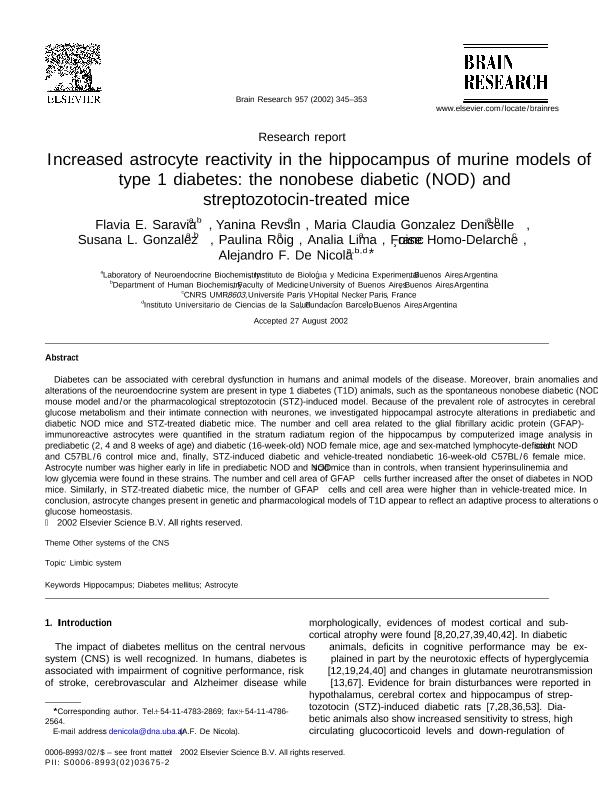Artículo
Increased astrocyte reactivity in the hippocampus of murine models of type I diabetes: the non-obese diabetic (NOD) and the streptozotocin-treated mice
Saravia, Flavia Eugenia ; Revsin, Yanina; Gonzalez Deniselle, Maria Claudia
; Revsin, Yanina; Gonzalez Deniselle, Maria Claudia ; Gonzalez, Susana Laura
; Gonzalez, Susana Laura ; Roig, Paulina
; Roig, Paulina ; Lima, Analia Ethel
; Lima, Analia Ethel ; Homo Delarche, Francoise; de Nicola, Alejandro Federico
; Homo Delarche, Francoise; de Nicola, Alejandro Federico
 ; Revsin, Yanina; Gonzalez Deniselle, Maria Claudia
; Revsin, Yanina; Gonzalez Deniselle, Maria Claudia ; Gonzalez, Susana Laura
; Gonzalez, Susana Laura ; Roig, Paulina
; Roig, Paulina ; Lima, Analia Ethel
; Lima, Analia Ethel ; Homo Delarche, Francoise; de Nicola, Alejandro Federico
; Homo Delarche, Francoise; de Nicola, Alejandro Federico
Fecha de publicación:
11/2002
Editorial:
Elsevier Science
Revista:
Brain Research
ISSN:
0006-8993
e-ISSN:
1872-6240 (
Idioma:
Inglés
Tipo de recurso:
Artículo publicado
Clasificación temática:
Resumen
Diabetes can be associated with cerebral dysfunction in humans and animal models of the disease. Moreover, brain anomalies and alterations of the neuroendocrine system are present in type 1 diabetes (T1D) animals, such as the spontaneous nonobese diabetic (NOD) mouse model and/or the pharmacological streptozotocin (STZ)-induced model. Because of the prevalent role of astrocytes in cerebral glucose metabolism and their intimate connection with neurones, we investigated hippocampal astrocyte alterations in prediabetic and diabetic NOD mice and STZ-treated diabetic mice. The number and cell area related to the glial fibrillary acidic protein (GFAP)-immunoreactive astrocytes were quantified in the stratum radiatum region of the hippocampus by computerized image analysis in prediabetic (2, 4 and 8 weeks of age) and diabetic (16-week-old) NOD female mice, age and sex-matched lymphocyte-deficient NODscid and C57BL/6 control mice and, finally, STZ-induced diabetic and vehicle-treated nondiabetic 16-week-old C57BL/6 female mice. Astrocyte number was higher early in life in prediabetic NOD and NODscid mice than in controls, when transient hyperinsulinemia and low glycemia were found in these strains. The number and cell area of GFAP(+) cells further increased after the onset of diabetes in NOD mice. Similarly, in STZ-treated diabetic mice, the number of GFAP(+) cells and cell area were higher than in vehicle-treated mice. In conclusion, astrocyte changes present in genetic and pharmacological models of T1D appear to reflect an adaptive process to alterations of glucose homeostasis.
Palabras clave:
Diabetes
,
Streptoxzotocin
,
Nod
,
Astrocytosis
Archivos asociados
Licencia
Identificadores
Colecciones
Articulos(IBYME)
Articulos de INST.DE BIOLOGIA Y MEDICINA EXPERIMENTAL (I)
Articulos de INST.DE BIOLOGIA Y MEDICINA EXPERIMENTAL (I)
Citación
Saravia, Flavia Eugenia; Revsin, Yanina; Gonzalez Deniselle, Maria Claudia; Gonzalez, Susana Laura; Roig, Paulina; et al.; Increased astrocyte reactivity in the hippocampus of murine models of type I diabetes: the non-obese diabetic (NOD) and the streptozotocin-treated mice; Elsevier Science; Brain Research; 957; 2; 11-2002; 345-353
Compartir
Altmétricas



